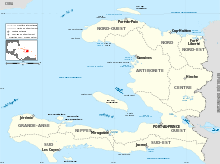Episcopal Diocese of Haiti
| Diocese of Haiti | |
|---|---|
| Location | |
| Ecclesiastical province | Province II |
| Statistics | |
| Congregations | 111 |
| Members | 84,562 (2015) |
| Information | |
| Rite | Episcopal |
| Cathedral | Holy Trinity Cathedral |
| Current leadership | |
| Bishop | Jean-Zaché Duracin |
| Map | |
 The diocese encompasses the entire country of Haiti. | |
| Website | |
| www.egliseepiscopaledhaiti.org | |
The Episcopal Diocese of Haiti (French: Eglise Episcopale d'Haïti) is the Anglican Communion diocese consisting of the entire territory of Haiti. It is part of Province 2 of the Episcopal Church in the United States of America. Its cathedral, Holy Trinity (French: Cathédrale Sainte Trinité) located in the corner of Ave. Mgr. Guilloux & Rue Pavée in downtown Port-au-Prince, has been destroyed six times, including in the 2010 Haiti earthquake.
It is the largest diocese in the Episcopal Church, with 86,760 members reported in 2010.[1]
Jean-Zaché Duracin is the current bishop of Haiti. Ogé Beauvoir is bishop suffragan.
History
Holy Trinity parish was established in Port-au-Prince on Pentecost, May 25, 1863. Its church has since been destroyed six times. The first church was set on fire by Sylvain Salnave in 1866; possibly the second, and definitely the third, were destroyed by fire in 1873; yet another by fire on July 4, 1888; and a fifth by fire on July 5, 1908. Construction of the sixth Holy Trinity began in 1924.[2]
In 1864, the first Diocesan Synod was held.[2] Then known as the Haitian Apostolic Orthodox Church, it was recognized as a member of the Anglican Communion in 1870. The Diocese of Haiti formally joined The Episcopal Church of the United States on May 15, 1875.[2] The first Haitian bishop of the diocese was Luc Garnier.
2010 earthquake
The 2010 Haiti earthquake destroyed much of the infrastructure of the diocese, including Holy Trinity Cathedral and its school, the diocesan offices, the Couvent Sainte Marguerite, the College Saint Pierre, at least four of the diocese's more than 200 schools, and the home of Duracin and his injured wife.[3]
Duracin and the church leadership set up a camp in Port-au-Prince "the size of a football field" where destitute and injured Haitians could seek refuge. Episcopal Relief and Development began working with the Episcopal Diocese of the Dominican Republic to help with Haitians who cross the border, and with IMA World Health to medical help to the wounded around Port-au-Prince.[4] Prior to the earthquake the Episcopal Diocese of Haiti’s Development Office had trained a network of 28 community development workers for disaster management. Since the quake, these development agents completed initial needs assessments for their own communities. Two weeks after the quake the Episcopal Diocese of Haiti and Episcopal Relief & Development were helping over 25,000 survivors in 23 camps. Many of the camps are located at the sites of Episcopal churches and schools and range in size from a few hundred people to approximately 8000. Six of the camps inhabited by more than 15,000 survivors were not accessible by vehicles were and were supplied by helicopter. Sanitation and clean water facilities were constructed for many of the camps.[5]
Bishops
- James Theodore Holly (1874-1911)
- Harry Roberts Carson (1923-43)
* Spence Burton (Suffragan) (1939-1942) - C. Alfred Voegeli (1943-1971)
- Luc Garnier (1971-1993)
- Jean-Zaché Duracin (1994-Present)
* Ogé Beauvoir (2012-Present) (Suffragan)
References
- ↑ "Baptized Members by Province and Diocese 2000-2010" (PDF). Episcopal Church Office of Research and Statistics. Retrieved 2012-01-07.
- 1 2 3 "Histoire" (in Haitian Creole). Port-au-Prince: Episcopal Diocese of Haiti. Retrieved 2010-01-17.
- ↑ Wilson, Lynette; Schjonberg, Mary Frances (2010-01-15). "'I was certain I was going to die': Caught in Haiti earthquake, Episcopal Church missionaries recount survival". Episcopal Life Online. New York City: Office of Communication, The Episcopal Church. Episcopal News Service. Retrieved 2010-01-17.
- ↑ "Diocese of Haiti Actively Responds in the Wake of Disaster with Support from Episcopal Relief & Development". New York City: Episcopal Relief and Development. 2010-01-15. Retrieved 2010-01-17.
- ↑ Episcopal Relief & Development Collaborating on Earthquake Response in Haiti Updated February 4, 2010
External links
- Eglise Episcopale D'Haïti (French) — official website
- La Liturgie ou Formulaire des Prières Publiques à l’usage du Collège Royal et des Ecoles Nationales d’Hayti c. 1815 liturgical text for use by this church, digitized by Richard Mammana
- Litiji Kreyol La Anglican Church liturgical materials in Kreyol digitized by Jean Fils Chery and Richard Mammana
Coordinates: 19°N 72°W / 19°N 72°W